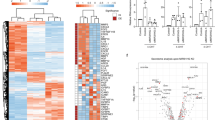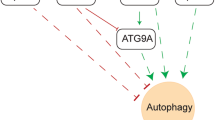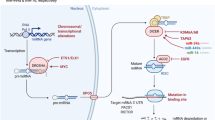Abstract
Aberrant oncogene activation induces cellular senescence, an irreversible growth arrest that acts as a barrier against tumorigenesis. To identify microRNAs (miRNAs) involved in oncogene-induced senescence, we examined the expression of miRNAs in primary human TIG3 fibroblasts after constitutive activation of B-RAF. Among the regulated miRNAs, both miR-34a and miR-146a were strongly induced during senescence. Although members of the miR-34 family are known to be transcriptionally regulated by p53, we find that miR-34a is regulated independently of p53 during oncogene-induced senescence. Instead, upregulation of miR-34a is mediated by the ETS family transcription factor, ELK1. During senescence, miR-34a targets the important proto-oncogene MYC and our data suggest that miR-34a thereby coordinately controls a set of cell cycle regulators. Hence, in addition to its integration in the p53 pathway, we show that alternative cancer-related pathways regulate miR-34a, emphasising its significance as a tumour suppressor.
Similar content being viewed by others
Log in or create a free account to read this content
Gain free access to this article, as well as selected content from this journal and more on nature.com
or
Abbreviations
- 4-OHT:
-
4-hydroxytamoxifen
- 4-tU:
-
4-thiouridine
- 5-FU:
-
5-fluorouracil
- ChIP:
-
chromatin immunoprecipitation
- EtOH:
-
ethanol
- miRNA:
-
microRNA
- PI:
-
propidium iodide
- SA-β-gal:
-
senescence-associated beta-galactosidase
References
d’Adda di Fagagna F, Reaper PM, Clay-Farrace L, Fiegler H, Carr P, Von Zglinicki T et al. A DNA damage checkpoint response in telomere-initiated senescence. Nature 2003; 426: 194–198.
Herbig U, Jobling WA, Chen BP, Chen DJ, Sedivy JM . Telomere shortening triggers senescence of human cells through a pathway involving ATM, p53, and p21(CIP1), but not p16(INK4a). Mol Cell 2004; 14: 501–513.
Takai H, Smogorzewska A, de Lange T . DNA damage foci at dysfunctional telomeres. Curr Biol 2003; 13: 1549–1556.
Serrano M, Lin AW, McCurrach ME, Beach D, Lowe SW . Oncogenic ras provokes premature cell senescence associated with accumulation of p53 and p16INK4a. Cell 1997; 88: 593–602.
Palmero I, Pantoja C, Serrano M . p19ARF links the tumour suppressor p53 to Ras. Nature 1998; 395: 125–126.
Courtois-Cox S, Genther Williams SM, Reczek EE, Johnson BW, McGillicuddy LT, Johannessen CM et al. A negative feedback signaling network underlies oncogene-induced senescence. Cancer Cell 2006; 10: 459–472.
Di Micco R, Fumagalli M, d’Adda di Fagagna F . Breaking news: high-speed race ends in arrest – how oncogenes induce senescence. Trends Cell Biol 2007; 17: 529–536.
Courtois-Cox S, Jones SL, Cichowski K . Many roads lead to oncogene-induced senescence. Oncogene 2008; 27: 2801–2809.
Mooi WJ, Peeper DS . Oncogene-induced cell senescence – halting on the road to cancer. N Engl J Med 2006; 355: 1037–1046.
Olsen CL, Gardie B, Yaswen P, Stampfer MR . Raf-1-induced growth arrest in human mammary epithelial cells is p16-independent and is overcome in immortal cells during conversion. Oncogene 2002; 21: 6328–6339.
Bushati N, Cohen SM . MicroRNA functions. Annu Rev Cell Dev Biol 2007; 23: 175–205.
Cho WC . OncomiRs: the discovery and progress of microRNAs in cancers. Mol Cancer 2007; 6: 60.
Bommer GT, Gerin I, Feng Y, Kaczorowski AJ, Kuick R, Love RE et al. p53-mediated activation of miRNA34 candidate tumor-suppressor genes. Curr Biol 2007; 17: 1298–1307.
Chang TC, Wentzel EA, Kent OA, Ramachandran K, Mullendore M, Lee KH et al. Transactivation of miR-34a by p53 broadly influences gene expression and promotes apoptosis. Mol Cell 2007; 26: 745–752.
Corney DC, Flesken-Nikitin A, Godwin AK, Wang W, Nikitin AY . MicroRNA-34b and MicroRNA-34c are targets of p53 and cooperate in control of cell proliferation and adhesion-independent growth. Cancer Res 2007; 67: 8433–8438.
Raver-Shapira N, Marciano E, Meiri E, Spector Y, Rosenfeld N, Moskovits N et al. Transcriptional activation of miR-34a contributes to p53-mediated apoptosis. Mol Cell 2007; 26: 731–743.
He L, He X, Lim LP, de Stanchina E, Xuan Z, Liang Y et al. A microRNA component of the p53 tumour suppressor network. Nature 2007; 447: 1130–1134.
Tarasov V, Jung P, Verdoodt B, Lodygin D, Epanchintsev A, Menssen A et al. Differential regulation of microRNAs by p53 revealed by massively parallel sequencing: miR-34a is a p53 target that induces apoptosis and G1-arrest. Cell Cycle 2007; 6: 1586–1593.
Pritchard CA, Samuels ML, Bosch E, McMahon M . Conditionally oncogenic forms of the A-Raf and B-Raf protein kinases display different biological and biochemical properties in NIH 3T3 cells. Mol Cell Biol 1995; 15: 6430–6442.
Zhu J, Woods D, McMahon M, Bishop JM . Senescence of human fibroblasts induced by oncogenic Raf. Genes Dev 1998; 12: 2997–3007.
Tazawa H, Tsuchiya N, Izumiya M, Nakagama H . Tumor-suppressive miR-34a induces senescence-like growth arrest through modulation of the E2F pathway in human colon cancer cells. Proc Natl Acad Sci USA 2007; 104: 15472–15477.
Shaulian E, Zauberman A, Ginsberg D, Oren M . Identification of a minimal transforming domain of p53: negative dominance through abrogation of sequence-specific DNA binding. Mol Cell Biol 1992; 12: 5581–5592.
Chang F, Steelman LS, Lee JT, Shelton JG, Navolanic PM, Blalock WL et al. Signal transduction mediated by the Ras/Raf/MEK/ERK pathway from cytokine receptors to transcription factors: potential targeting for therapeutic intervention. Leukemia 2003; 17: 1263–1293.
Loots GG, Ovcharenko I, Pachter L, Dubchak I, Rubin EM . rVista for comparative sequence-based discovery of functional transcription factor binding sites. Genome Res 2002; 12: 832–839.
Dennis Jr G, Sherman BT, Hosack DA, Yang J, Gao W, Lane HC et al. DAVID: Database for Annotation, Visualization, and Integrated Discovery. Genome Biol 2003; 4: P3.
Sun F, Fu H, Liu Q, Tie Y, Zhu J, Xing R et al. Downregulation of CCND1 and CDK6 by miR-34a induces cell cycle arrest. FEBS Lett 2008; 582: 1564–1568.
Linhart C, Halperin Y, Shamir R . Transcription factor and microRNA motif discovery: the Amadeus platform and a compendium of metazoan target sets. Genome Res 2008; 18: 1180–1189.
Orom UA, Nielsen FC, Lund AH . MicroRNA-10a binds the 5′UTR of ribosomal protein mRNAs and enhances their translation. Mol Cell 2008; 30: 460–471.
Welch C, Chen Y, Stallings RL . MicroRNA-34a functions as a potential tumor suppressor by inducing apoptosis in neuroblastoma cells. Oncogene 2007; 26: 5017–5022.
Bagchi A, Mills AA . The quest for the 1p36 tumor suppressor. Cancer Res 2008; 68: 2551–2556.
Lodygin D, Tarasov V, Epanchintsev A, Berking C, Knyazeva T, Korner H et al. Inactivation of miR-34a by aberrant CpG methylation in multiple types of cancer. Cell Cycle 2008; 7: 2591–2600.
Ohtani N, Zebedee Z, Huot TJ, Stinson JA, Sugimoto M, Ohashi Y et al. Opposing effects of Ets and Id proteins on p16INK4a expression during cellular senescence. Nature 2001; 409: 1067–1070.
Kumamoto K, Spillare EA, Fujita K, Horikawa I, Yamashita T, Appella E et al. Nutlin-3a activates p53 to both down-regulate inhibitor of growth 2 and up-regulate mir-34a, mir-34b, and mir-34c expression, and induce senescence. Cancer Res 2008; 68: 3193–3203.
Frankel LB, Christoffersen NR, Jacobsen A, Lindow M, Krogh A, Lund AH . Programmed cell death 4 (PDCD4) is an important functional target of the microRNA miR-21 in breast cancer cells. J Biol Chem 2008; 283: 1026–1033.
Krutzfeldt J, Rajewsky N, Braich R, Rajeev KG, Tuschl T, Manoharan M et al. Silencing of microRNAs in vivo with ‘antagomirs’. Nature 2005; 438: 685–689.
Raver-Shapira N, Oren M . Tiny actors, great roles: microRNAs in p53's service. Cell Cycle 2007; 6: 2656–2661.
Wei JS, Song YK, Durinck S, Chen QR, Cheuk AT, Tsang P et al. The MYCN oncogene is a direct target of miR-34a. Oncogene 2008; 27: 5204–5213.
Leucci E, Cocco M, Onnis A, De Falco G, van Cleef P, Bellan C et al. MYC translocation-negative classical Burkitt lymphoma cases: an alternative pathogenetic mechanism involving miRNA deregulation. J Pathol 2008; 216: 440–450.
Kong YW, Cannell IG, de Moor CH, Hill K, Garside PG, Hamilton TL et al. The mechanism of micro-RNA-mediated translation repression is determined by the promoter of the target gene. Proc Natl Acad Sci USA 2008; 105: 8866–8871.
Zhuang D, Mannava S, Grachtchouk V, Tang WH, Patil S, Wawrzyniak JA et al. C-MYC overexpression is required for continuous suppression of oncogene-induced senescence in melanoma cells. Oncogene 2008; 27: 6623–6634.
Wu CH, van Riggelen J, Yetil A, Fan AC, Bachireddy P, Felsher DW . Cellular senescence is an important mechanism of tumor regression upon c-Myc inactivation. Proc Natl Acad Sci USA 2007; 104: 13028–13033.
Guney I, Wu S, Sedivy JM . Reduced c-Myc signaling triggers telomere-independent senescence by regulating Bmi-1 and p16(INK4a). Proc Natl Acad Sci USA 2006; 103: 3645–3650.
Littlewood TD, Hancock DC, Danielian PS, Parker MG, Evan GI . A modified oestrogen receptor ligand-binding domain as an improved switch for the regulation of heterologous proteins. Nucleic Acids Res 1995; 23: 1686–1690.
Fujita N, Wade PA . Use of bifunctional cross-linking reagents in mapping genomic distribution of chromatin remodeling complexes. Methods 2004; 33: 81–85.
Acknowledgements
We thank Dr. Robert A Hipskind for kindly providing us with the ELK1 expression construct and Dr. Martin Bushell for kindly providing us with the MYC 3′UTR luciferase constructs, pLSV-M3′ and pLSV-M3′MUT. Work in the authors’ laboratories has been supported by the EC FP7 funding (ONCOMIRS, grant agreement number 201102. The commission is not liable for any use that may be made of the information herein), the Vilhelm Pedersen and Hustrus Foundation, the Danish National Research Foundation, the Danish Medical Research Council, the Danish Cancer Society and the Association for International Cancer Research. This publication reflects only the authors’ views.
Author information
Authors and Affiliations
Corresponding author
Additional information
Edited by G Melino
Supplementary Information accompanies the paper on Cell Death and Differentiation website (http://www.nature.com/cdd)
Rights and permissions
About this article
Cite this article
Christoffersen, N., Shalgi, R., Frankel, L. et al. p53-independent upregulation of miR-34a during oncogene-induced senescence represses MYC. Cell Death Differ 17, 236–245 (2010). https://doi.org/10.1038/cdd.2009.109
Received:
Revised:
Accepted:
Published:
Issue date:
DOI: https://doi.org/10.1038/cdd.2009.109
Keywords
This article is cited by
-
A comprehensive review on RNA interference-mediated targeting of interleukins and its potential therapeutic implications in colon cancer
3 Biotech (2023)
-
Role of microRNA-34b-5p in cancer and injury: how does it work?
Cancer Cell International (2022)
-
A novel lncRNA MTAR1 promotes cancer development through IGF2BPs mediated post-transcriptional regulation of c-MYC
Oncogene (2022)
-
Obesity, leptin, and deregulation of microRNA in lipid metabolisms: their contribution to breast cancer prognosis
Diabetology & Metabolic Syndrome (2021)
-
MicroRNA-34a: the bad guy in age-related vascular diseases
Cellular and Molecular Life Sciences (2021)



